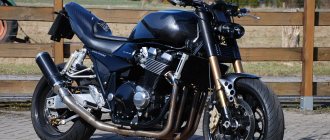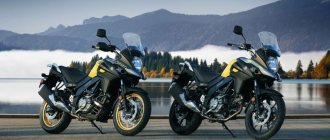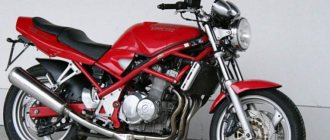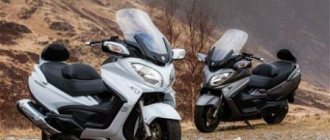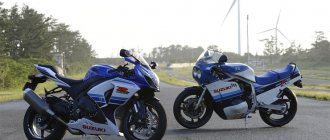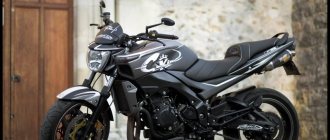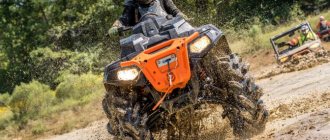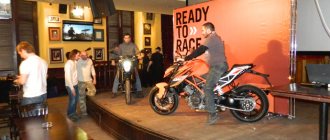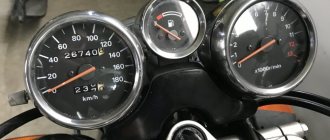The Suzuki Bandit 1250 is a road bike that is suitable for experienced motorcyclists who want to enjoy speed and maneuverability. The model became a replacement for the Bandit 1200 and was released in 2007. Production of the device lasted from 2007 to 2010. In 2010, a new modification of the model called Suzuki GSX1250FA Bandit was released. In 2012, the model was discontinued and no longer sold. Already in 2015, the version was visually changed, the design and characteristics were changed.
Features and model range
Unlike the old version, the updated devices were equipped with a liquid-cooled engine, electronic fuel injection and received a number of other changes. Suzuki Bandit 1250 is highly powerful and produces 98 hp (108 Nm). Although it seems that the changes with the previous version are not so obvious, the manufacturer managed to significantly level out the power and increase traction at revs. The old model produced 6500 rpm, and the new version already produces 3700 rpm.
The main features of the presented motorcycle include:
- Steel frame.
- Regular pendants.
- Hydraulic clutch.
- 6-speed gearbox.
- Piston front brakes are reliable and powerful.
- Adjustable seat.
- system
- Fuel tank with a capacity of 19 liters.
The lineup contains several Suzuki GSF Bandit models:
- GSF400 Bandit.
- GSF600 Bandit.
- GSF650 Bandit.
- GSF750 Bandit.
- GSF1200 Bandit.
- GSF1250 Bandit.
The main competitors of the model are:
- Honda CB1000R / Honda CBF 1000;
- Kawasaki Z1000;
- Yamaha FZ1.
Description
The Suzuki GSF1250 Bandit road motorcycle model was introduced in 2007 as a replacement for the Suzuki GSF 1200 Bandit. Unlike its predecessor, the model received a number of technical changes:
Engine. It received liquid cooling, a second balance shaft, an injection power system and increased its volume from 1157 to 1255 cm³. Maximum power remained at 100 hp, but the engine speed was reduced, which increased torque at low speeds. Brake system. Returns to 4-piston calipers and the availability of ABS versions. Transmission. Instead of the old 5-speed, the model gets a more modern 6-speed. Fuel tank. The capacity is reduced from 20 to 19 liters. In 2012, the naked version without a fairing (GSF1250) was discontinued and is no longer offered by dealers, leaving only the version with a front fairing (GSF1250S) on the market.
In 2015, the Suzuki GSF1250S Bandit model received a slight update in appearance (now plastic covers the radiator), and in 2016 it was discontinued.
In 2010, on a common base with the GSF1250, a sport-touring modification was proposed - the Suzuki GSX1250F.
Technical characteristics of the Suzuki Bandit 1250 model
The Suzuki 1250 motorcycle, released in 2007, is still on sale. The devices are very popular among fans of fast and comfortable driving.
The bike has several more important technical characteristics:
- The highest torque is 108 Nm at 3700 rpm.
- Gearbox - 6-speed.
- The maximum speed is 225 km/h.
- The vehicle accelerates to 100 km in 3.2 seconds.
- The gas tank capacity is 19 liters.
- The dry weight of the motorcycle is 225 kg.
- The adjustable saddle rises to a height of 785-805 mm.
- The height of the bike is 1095 cm.
- Length - 2135cm.
- Engine capacity - 1255 cc.
- Ground clearance - 135 mm.
In addition to technical characteristics, the motorcycle boasts its design. Everyone will like him. The vehicle is started using an electronic ignition.
In addition, an important attribute of a motorcycle is its engine. It features electronic fuel injection and liquid cooling. The engine of the model is 4-cylinder and four-stroke. Power is distributed evenly, allowing you to accelerate in every gear.
Design features of transport:
- Aluminum double-tube frame.
- The front suspension is angled like a telescopic fork with a coil spring.
- Reinforced rear suspension to withstand high loads.
This article will be the own opinion of the non-believing Banditovod) That is. me) I had a lot of them, different ones, starting from 400 and up to the largest ones. Carburetor and injection. For the last five years I’ve been riding a 1250S, injected (1250 is all injected), I was without ABS, now I’m with ABS.
My height is 183 cm, weight at the beginning of this season is 107 kg, now 96 kg (average 100 kg). This is to understand how “heavy” the motorcycle is, what kind of wind protection it has, how it rides under load, etc. etc.
I bought the car as is, in Blagoveshchensk, I am the second owner according to the title, the mileage at the time of purchase was 7,000 km. Or so. Motorcycle from Japan. Japanese version, with a cut-off speed of 195 km/h.
Installed on the moto not from stock (everything that is not stock on it is all from Japan, i.e. the moto sailed from there exactly in this form): Yoshimura muffler, Givi mount and case (only the rear one for 35 liters), side plastic ( a la GSX), GiPro-DS gear indicator (gears only, does not affect the brain, does not remove the restriction), Puig carbon fiber hugger.
Go! )
Regarding the human factor: Landing . It’s comfortable, almost smooth, I don’t look like a shrimp on it. I covered different distances, my back and arms didn’t go numb, my knees didn’t ache. 750-1000 at once is normal. One minus is that the gluteal muscles, if you will, start to hurt. And quite quickly, after 200-300 km, there is a solution - gel seats, but I don’t bother, 250-300 km on average and refueling, there’s more rest there.
Wind protection . Given my height, the stock glass is a little small, quite a bit small, but there is a solution - MPA or Puig touring glass, and also a spoiler on top, which is absolutely beautiful. I have enough neck and strength not to hide (not lie on the tank) behind the glass at maximum speed. I sit up straight, hold my head up, the windage is huge, but the ride is quite comfortable if there is no side wind, otherwise it blows away). The additional side plastic, I don’t know what it affects or whether it affects it at all. The last moto was without it, I didn’t understand the difference, I didn’t notice it. Probably just for beauty and price)
Controllability . Very good for me. Both in a straight line and turns at the additional stage (I haven’t driven on the track, I can’t say anything) it goes with a bang, the main thing is not to mess up). For me it is heavy at the very beginning of the season when you roll it out of the garage. It looks like it weighs a ton! But a couple of weeks of training and a bike)
What does NOT concern the human factor (or partially concerns): Consumption . I can say with complete confidence that the minimum consumption starts from 5 (even 4.9) liters per hundred (95 benz). Those. on a full tank (the tank is full) on this motorcycle I travel 400 km without refueling. This consumption will be if you drive at a speed of 90 km/h. Yes, it’s vomiting, but it’s real and sometimes it can come in handy. The maximum consumption I could achieve was 12 liters per hundred. On the highway, if you keep 180-190 km/h all the time - 9-10 liters per hundred. At a speed of 150-160 (for me this is the most comfortable on this bike on the highway) 7-8 liters per hundred. Here's another thing, the tank of this motorcycle contains 20 liters of gasoline (+-200 milliliters), different sources give different information (18-19). Of course, you have to move it to the sides, tug it back and forth to let the air out, but it comes in (and comes out))).
ABS . This is the first bike I've ever owned that has this thing on it. And I am glad of this circumstance! The system is not combined, i.e. front and back don't work together. If you pinched the rear, ABS will only work on the rear wheel, the same with the front wheel. Somewhere on this resource there were holivars on this topic, what is good and what is bad. I think this is good! Yes, it is somewhat relaxing, but at the same time it almost eliminates the fear of slamming on the brakes. Believe me, as before, I constantly train my emergency braking skills. And ABS can only help me! Because if I overpressure, the wheel will not skid, but the ABS will simply work. That's all love...
Power . There are 100 horses in stock and huge torque. On this motor you can leave speeds 1 and 6, and even add 7. The first one accelerates to 100 (or 120 before the cutoff), and then in sixth it accelerates quite well (even with two passengers and 50 kilos of swag). You can even start from 6th gear. The rear wheel is driven in first gear without a clutch, only with gas (taking into account its mass and the mass of the steering wheel!). Up to a hundred 3 seconds, up to 200 did not detect)
Reliability, maintainability, consumables, maintenance, etc. Engine . The mot is made to perfection. The engine resource allows you to not even climb into it for the first 100,000 km. Of course, subject to proper maintenance and service. An oil change is recommended every 6 thousand km, 10 thousand on one oil is normal. Filter every second oil change. It may be necessary to adjust the valves (on water bandos they use washers) and synchronization. Although this procedure is recommended, if I’m not mistaken, every 24 thousand km, and every 16 thousand km. I climbed there at both 16 and 24 - there’s nothing to do there, all the gaps are normal. Finding a service manual for this motor on the Internet is not a problem, everything is detailed there.
Chain and stars . My bike has covered about 53,000 km and only now is it time to change the chain, because it has not stretched evenly. At about 45 I changed the rear sprocket, the drive is still fine. And why is it because you have to smear it! Yes, lubricant is not cheap, but how much is a chain + sprocket kit now? That's right, a lot! It's much cheaper to smear. And an auto lubricant is even cheaper! And, believe me, an auto lubricator, all other things being equal, will extend the life of the chain by another 20-30 thousand. As a result, with proper care of the chain, it can safely run 50 thousand km. I always want to ask those who sell motorcycles, but in the description the mileage is, for example, 11,000 km, and the chain is already stretched, that the tensioner is stuck, what was done with this motorcycle? Or the mileage is 111,000 km... For example, two photos, one shows my motor with a mileage of 52 thousand km, and the second shows 11 thousand km.
Pads and brake discs . The front pads (original from the factory) covered approximately 38-40 thousand km, the rear ones 45-48. The discs have no visible wear, are even and smooth. Of course, there is some wear, but it is so small that it is not worth paying attention to. If you see a motorcycle for sale with a mileage of 20-30 thousand km, and the description says that the pads are replaced in a circle, you have to think about why they were changed so early?
Hodovka . Fork and rear shock absorber, wheels (bearings). The motor has already driven for 50 thousand. km. And not a drop of oil is visible around the seals, no signs that it is time to change the seals. Feathers without scratches, shells, rust, etc. I know a motor with almost twice as much mileage, the situation is the same, everything is clean and beautiful, without beating or play. BUT you need to change the oil according to the manual, or at least once a season. Because the internal parts of the fork wear out and there will be play, and this is a very expensive repair. A fork with a reserve for this moto and passengers. I don’t travel alone a lot, and that’s 100kg of my weight + 60kg of passenger + 10-15kg of belongings. For the rear one to leak out on this bike - I’ve never heard of that at all. On my motor the bearings are fine.
Electrics . What can I say? Nothing. Everything is simple, everything is smooth. There is enough generator. I hooked up the cigarette lighter, the car pump runs without problems, phone chargers, etc. too. There is a car alarm. Yes, I remembered one problem that can arise on these motors (650 and 1250) - the fuel pump. On this motor, under no circumstances should you drain the tank as soon as the pump grabs air and begins to idle - consider it a khan. But not completely. It will work, but poorly. This is expressed in failures at high speeds (from 3 thousand), the engine does not have enough gasoline, because. the pump is not able to supply it in sufficient quantity and at sufficient pressure. There is one more small nuisance that may seem like a huge problem - the limit switch on the clutch. To start this engine you need to squeeze the clutch, then the limit switch closes and the starter starts turning. So it turns sour over time, or the contacts burn out, or the contacting plates get crushed and there is no contact. Repair is simple - disassemble, clean, bend and at the same time order a new one.
Filter and fluid . Change according to the manual. All. ))
PS A little usual gag. The engine is reliable, any gasoline can be used, but it is better to fill it at proven gas stations. It is not at all fussy about maintenance, the main thing is not to be lazy about lubricating the chain. Change fluids according to the manual. I use both synthetic and synthetic oil. On semi-synthetics, the disappearance of 100 milliliters of oil was noticed per 6 thousand km, with synthetics, as much as you filled in and drained when replacing. Bleeding the brakes does not cause any difficulty when replacing the brake fluid. I changed the coolant only once, about 30 thousand.
For those who want a fashionable jar instead of a huge crap. Yes, the stock jammer is a perversion (all for the sake of the environment and noiselessness), a beautiful can is much more pleasing to the eye. But there is also a minus that I noticed - this is the volume and range. Believe me, with a stock muffler, your head will thank you on long trips. I really got high when I had to temporarily change Yasha to stock. But I won’t install stock for myself))) the sound is too pleasant with Yasha))
I have never painted or polished it. The tank was protected with honeycombs and a sticker, and the wheels were decorated. We also need to protect the top of the tank, around the neck, because out of habit I put the helmet there (you can see it in the first photo) and over time scratches appear and need polishing. The photo shows that some of the honeycombs have been torn off by knee pads. They were like enduro rides)) If there weren’t honeycombs or other protection, the paint would have been torn off. And so I glued new ones, cheap and cheerful)
Case! This is a brilliant invention of mankind! This is my first bike with a case. This, I repeat, is brilliant! Previously, backpacks, bags, nets, ahhhh. Now all the little things are there, the raincoat is registered there. There's a lot of beer included))
One seemingly unnoticeable, but ESSENTIAL plus of this moto is the central stand. I won’t describe all its advantages. But its value is not exaggerated by me.
The motor is “strangled”, the speed limit is limited. All this can be edited if necessary. And he will go for 260) But I don’t need it) He’s already driving his 200 in 3rd gear. There is so much power that you could use 7th gear and at a speed of 200 the fuel consumption would be 6-7 liters))
The Japanese come with orange turn signals (namely glass), the Europeans have transparent ones. The Japanese limit is 195 km/h, the Europeans are 260 km/h. The devices are the same, but they can be switched (switched) in miles instead of kilometers, all this is easily edited with two buttons on the device.
Yesterday, December 24, 2015, I closed the season and moved the bike from the parking lot to a warm garage. The engine started without problems (I haven’t started it since the beginning of October), no knocking from the engine, etc. It runs smoothly, purrs)))
Yes, only 78 horses were indicated in the PTS during customs clearance))
Fuel consumption and cost
According to official data, the device consumes 5.4 liters of fuel per 100 km. However, gasoline consumption depends on the condition of the bike, road conditions and driving style. Owners note that the device consumes approximately 6-6.5 liters of fuel per 100 km.
The cost of the model depends on its condition. The pricing policy is very affordable, so the Bandit 1250 is often purchased by beginners and amateurs. The cost of a model in good condition and without mileage starts at $5,500. The price of a used bike in Russia starts from 200,000 rubles.
Repair and tuning
Even with a minor breakdown, Suzuki needs repair. To repair your bike, you need to go to a private garage or a good mechanic. The only downside is that it can cost a lot of money. Spare parts can be found on the Internet, ordered from a dealer, or found a suitable analogue. An attractive bike does not need special tuning. The user can install a new wind protection or change discs.
Pros and cons of the Suzuki Bandit 1250
The advantages of transport include:
- Motor power.
- Reliable and robust design.
- Attractive appearance.
- Reliable brakes.
- Spacious fuel tank.
- Excellent handling and maneuverability.
- Reasonable price.
Unfortunately, there are also disadvantages. These include:
- Weak wind protection.
- Problems finding suitable spare parts.
- The engine is poorly protected from damage.
Brief history of the model
2007 - start of production and sales. Model: Suzuki GSF1250 Bandit + ABS; Suzuki GSF1250S Bandit + ABS (Japan, North America, Europe). Factory designation: GSF1250K7 + GSF1250AK7; GSF1250SK7 + GSF1250SAK7.
2008 - no significant changes. A touring version of the GSF1250S with a proprietary pannier system is also offered. Model: Suzuki GSF1250 Bandit + ABS; Suzuki GSF1250S Bandit + ABS (Japan, North America, Europe). Factory designation: GSF1250K8 + GSF1250AK8; GSF1250SK8 + GSF1250SAK8.
2009 - no significant changes. Model: Suzuki GSF1250 Bandit + ABS; Suzuki GSF1250S Bandit + ABS (Japan, North America, Europe). Factory designation: GSF1250K9 + GSF1250AK9; GSF1250SK9 + GSF1250SAK9.
2010 - starting this year, the model is available with a black engine. Model: Suzuki GSF1250 Bandit + ABS; Suzuki GSF1250S Bandit + ABS (Japan, North America, Europe). Factory designation: GSF1250L0 + GSF1250AL0; GSF1250SL0 + GSF1250SAL0.
2011 - no significant changes. Model: Suzuki GSF1250 Bandit + ABS; Suzuki GSF1250S Bandit + ABS (Japan, North America, Europe). Factory designation: GSF1250L1 + GSF1250AL1; GSF1250SL1 + GSF1250SAL1
2012 is the last year of production of the naked version. Model: Suzuki GSF1250 Bandit + ABS; Suzuki GSF1250S Bandit + ABS (Japan, North America, Europe). Factory designation: GSF1250L2 + GSF1250AL2; GSF1250SL2 + GSF1250SAL2
2013 - no significant changes. Model: Suzuki GSF1250S Bandit (ABS) (Japan, North America, Europe). Factory designation: GSF1250SAL3
2014 - no significant changes. Model: Suzuki GSF1250S Bandit (ABS) (Japan, North America, Europe). Factory designation: GSF1250SAL4
2015 - starting this year, the model is produced with new plastic covering the radiator. An additional opening appears under the headlight to smooth the air flow behind the windshield. Model: Suzuki GSF1250S Bandit (ABS) (Japan, North America, Europe). Factory designation: GSF1250SAL5
2016 is the last year of production. Model: Suzuki GSF1250S Bandit (ABS) (Japan, North America, Europe). Factory designation: GSF1250SAL6
